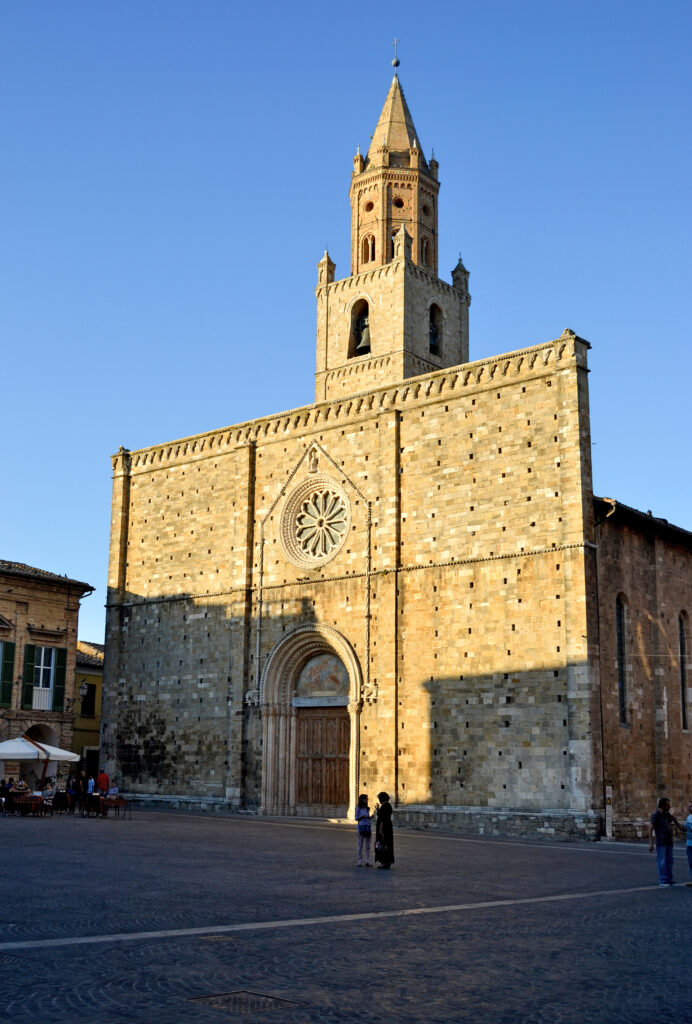
Atri

By Nancy DeSanti
Province of Teramo, Region of Abruzzo
The beautiful small town of Atri is located in the province of Teramo. It has approximately 12,580 inhabitants, known as Atriani. Located six miles from the Adriatic Sea, it may be one of the oldest cities in Abruzzo. Atri is the setting of the poem “The Bell of Atri“ by American poet Henry Wadsworth Longfellow. Its name is thought to come from the name of the Emperor Hadrian, whose family came from the town.

Credit: Wikipedia
On the top of a 3-pointed hill near the Adriatic with the majestic Gran Sasso in the background, and in a key position above the Val Vomano, the town was famous and powerful in antiquity and is today considered one of the most important historical, cultural, and artistic centers in Abruzzo. The surrounding landscape is also impressive for the canyon-like coves and the partly unexplored caves.
Called Hatria in Roman times, the town was a Roman colony from which, many historians believe, the name of the Adriatic Sea is also derived. In the 6th century B.C., the town was one of the four major Greek harbors on the Adriatic. In 290, it was conquered by Rome. After the fall of the Roman Empire, the territory came under the power of the Lombards in the 6th century and was annexed to the Duchy of Spoleto. Then the Normans came, and in 1393, Atri was bought by the House of Acquaviva, under whose power a period of great splendor for the city began. At the end of the 18th century, it was given by the Acquaviva to the Kingdom of Naples.
In the Villa Comunale dei Cappuccini, there are caves, probably once used as stables by the Capuchin friars. It is likely that they were also used to escape during pirate raids. Close to the lookout over the sea and all of the valleys of the Terre del Cerrano (from Roseto degli Abruzzi up to Silvi Marina), there is a fountain, considered the emblem of the Villa Comunale.
Another symbol of the villa, renovated in the 1930s in an Italian garden, is the formaggione (the big cheese), a cylindrically shaped hedge, comprising conifers, with four entrances (located at the cardinal points). It represents the Garden of Secrets, a recurring element in many gardens of the castles and the noble villas of Italy, especially between the late 18th and early 19th century.
Atri is also the home of Sartoria dei Duchi, a bespoke menswear atelier where the founder, Piero Pavone, keeps alive the craftsmanship of Italian men’s tailoring, specifically the craftsmanship of the Abruzzo region.
While Atri may be a small village, what Pavone said what he offers at Sartoria dei Duchi is world-class and has garnered a global consumer demand which has driven the expansion of the brand into markets such as Dubai and Singapore, with upcoming locations in London and Saudi Arabia. He said consumers fall in love with the history-infused proposition of the brand, but continue to come back for its heritage craftsmanship made with the finest textiles available from houses such as Loro Piana and Piacenza.
What to See
- Cattedrale di Santa Maria Assunta from the late 12th century
- Palazzo Ducale Acquaviva, a fortress built on the highest point of the town, now the seat of the municipality;
- Medieval walls, with Porta Macelli and Porta San Domenico
- Museo Capitolare
- Church of San Francesco, with a beautiful baroque flight of stairs
- Church of San Domenico, with two fine paintings by Giacomo Farelli from the 17th century
- Grottos, partly still unexplored, probably prehistoric settlements
Important Dates
- January 1 — “Lu S. Antonio”
- Holy Friday — representation of the Passion at nearby Villa Bozza
- Ferragosto week — Sagra delle Anguille
- August 15 — “La Maggiolata,” a train of traditional oxen-drawn wagons and folk groups
- August 18 — Feast of “tagliolini”, beans, prosciutto, and cheese
- August 19 — celebration of San Gabriele
- December 8 — the “faugni,” fires of dry canes in front of the cathedral at dawn.
Italiano

Tradotto da Ennio Di Tullio
Provincia di Teramo, Regione Abruzzo
La bellissima cittadina di Atri si trova in provincia di Teramo. Conta circa 12.580 abitanti, detti Atriani. Situata a sei miglia dal mare Adriatico, è forse una delle città più antiche d’Abruzzo. E Atri è l’ambientazione del poema “The Bell of Atri” dello scrittore americano Henry Wadsworth Longfellow. Il suo nome si pensa derivi dal nome dell’imperatore Adriano, la cui famiglia proveniva dalla città.
Sulla sommità di un colle a 3 punte a ridosso dell’Adriatico con il maestoso Gran Sasso sullo sfondo, e in posizione chiave sopra la Val Vomano, il paese fu famoso e potente nell’antichità ed è oggi considerato uno dei più importanti centri storici, centri culturali, e artistici in Abruzzo. Il paesaggio circostante è impressionante anche per le insenature simili a canyon e le grotte in parte inesplorate.
Hatria fu colonia romana da cui molti storici fanno derivare anche il nome del Mare Adriatico. Nel VI secolo aC, la città era uno dei quattro maggiori porti greci nel mare Adriatico. Nel 290 fu conquistata da Roma. Dopo la caduta dell’Impero Romano, nel VI secolo il territorio passò sotto il potere dei Longobardi e fu annesso al Ducato di Spoleto. Poi vennero i Normanni e nel 1393 Atri fu acquistata dalla Casa degli Acquaviva, sotto il cui potere iniziò un periodo di grande splendore per la città. Alla fine del ‘700 fu ceduto dagli Acquaviva al Regno di Napoli.
Nella Villa Comunale dei Cappuccini sono presenti delle grotte, probabilmente un tempo utilizzate come stalle dai frati cappuccini. È probabile che servissero anche per fuggire durante le incursioni dei pirati. Vicino al belvedere sul mare e su tutte le valli delle Terre del Cerrano (da Roseto degli Abruzzi fino a Silvi Marina), si trova una fontana, considerata l’emblema della Villa Comunale.
Altro simbolo della villa, ristrutturata negli anni ’30 a giardino all’italiana, è il formaggione, una siepe di forma cilindrica, composta da conifere, con quattro ingressi (posti ai punti cardinali). Rappresenta il Giardino dei Segreti, elemento ricorrente in molti giardini dei castelli e delle ville nobiliari d’Italia, soprattutto tra la fine del Settecento e l’inizio dell’Ottocento.
Atri è anche la sede della Sartoria dei Duchi, un atelier di abbigliamento maschile su misura dove il fondatore, Piero Pavone, mantiene viva l’artigianalità della sartoria maschile italiana, in particolare l’artigianato della regione Abruzzo.
Mentre Atri può essere un piccolo villaggio, ciò che Pavone ha detto ciò che offre alla Sartoria dei Duchi è di classe mondiale e ha raccolto una domanda di consumatori globale che ha guidato l’espansione del marchio in mercati come Dubai e Singapore, con sedi future a Londra e l’Arabia Saudita. Ha detto che i consumatori si innamorano della proposta intrisa di storia del marchio, ma continuano a tornare per il suo patrimonio artigianale realizzato con i migliori tessuti disponibili da case come Loro Piana e Piacenza.
Le attrazioni del luogo:
- Cattedrale di Santa Maria Assunta della fine del XII secolo
- Palazzo Ducale Acquaviva, fortezza costruita sul punto più alto del paese, oggi sede del comune;
- Mura medievali, con Porta Macelli e Porta San Domenico
- Museo Capitolare
- Chiesa di San Francesco, con una bella scalinata barocca
- Chiesa di San Domenico, con due pregevoli tele di Giacomo Farelli del XVII secolo
- Grotte, in parte ancora inesplorate, probabilmente insediamenti preistorici
Date da ricordare:
- 1 gennaio — “Lu S. Antonio”
- Venerdì Santo — rappresentazione della Passione presso la vicina Villa Bozza
- Settimana di Ferragosto — Sagra delle Anguille
- 15 agosto — “La Maggiolata”, convoglio di tradizionali carri trainati da buoi e gruppi folkloristici
- 18 agosto — Sagra dei tagliolini, fagioli, prosciutto, e formaggio
- 19 agosto — festa di San Gabriele
- 8 dicembre — i “faugni”, fuochi di canne secche davanti alla cattedrale all’alba.
July/August 2023





